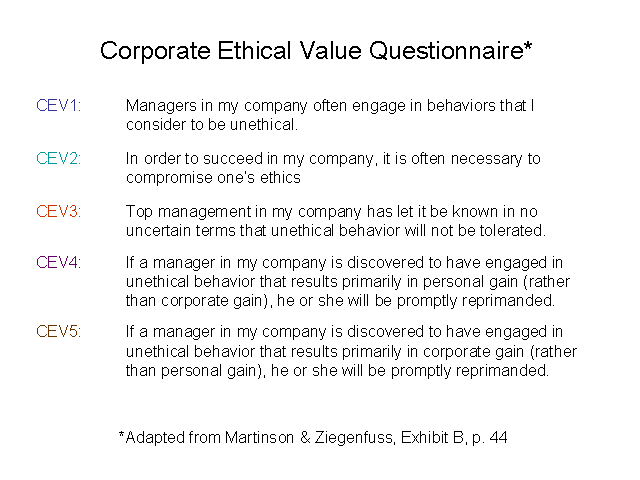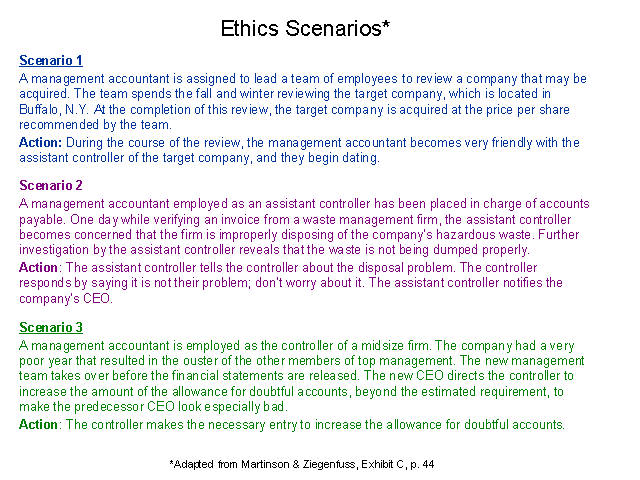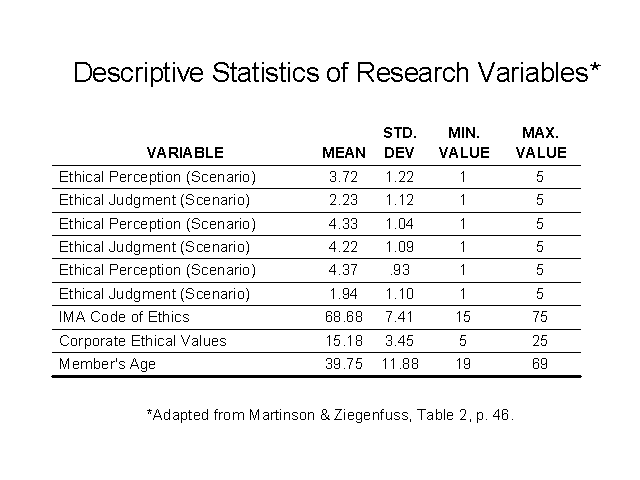
Summary by Adebola Shokunbi
Master of Accountancy Program
University of South Florida, Fall 2004
Behavioral Issues Main Page | Ethics Main Page
This article presents a study to investigate the influences on the ethical behavior of persons who are involved in financial management. In particular, the study focuses on the correlation between the IMA members’ rating of IMA code elements as “possible guiding principles” and their personal ethical perception and judgment. It also analyzes the influence of age, corporate ethical values, and experience on the ethical conduct of members.
In 1985, the National Commission on Fraudulent Financial Reporting (Commonly known as the Treadway Commission) was established as a result of the increase in fraudulent financial reporting. In a report released by the Commission in 1987, the responsibility for financial reporting was placed precisely on management and the board of directors. This accountability advanced the role of financial management to a higher level. The Treadway Commission noted that “’the tone at the top’ is an essential element of establishing and maintaining an ethical environment” (p. 42). The Commission asserted that the foundation for the overall ethical environment should be established by the Chief Financial Officer, a member of top management. In addition, the Commission recommended the development and implementation of written codes of conduct by all companies.
Background
In 1983 the IMA issued a code of ethics for management accountants named “Standards of Ethical Conduct for Management Accountants.” The increasing scope of accounting and related ethical issues lead to the renaming of the code: “Standards of Ethical Conduct for Practitioners of Management Accounting and Financial Management.” The code of ethics established four aspects of responsibility that persons in financial management must fulfill: competence, confidentiality, integrity, and objectivity. In addition, a special section titled “Resolution of Ethical Conflict” illustrates techniques for resolving ethical circumstances and states how they should be reported and handled within the organization.
What Influences Ethical Behavior?
The study was brought about by the constant pressure faced by individuals in financial management to modify and manipulate the numbers in the preparation of financial reports, operating budgets, or capital budgets.
Previous Studies
Although a number of studies have analyzed the IMA code of ethics and management accountants’ ethical decision making, none has examined whether the code truly impacts the ethical perception and judgment of IMA members.
The Study
Hypothesis Development
The hypotheses were as follows:
“Hypothesis 1 . A statistically significant relationship will exist between the importance placed by IMA members on elements of the IMA code of ethics and their ethical perception and judgment.
Hypothesis 2 . A statistically significant relationship will exist between the corporate ethical environment of the organization employing the IMA member and his or her ethical perception and judgment.
Hypothesis 3 . A statistically significant relationship will exist between an IMA member’s age/experience and his or her ethical perception and judgment” (p. 43).
Operationalization of Variables
IMA Code of Ethics. Respondents were given a listing of the 15 rules that make up the IMA code of ethics and were asked to rate them as “possible guiding principles” in their work. Their answers were evaluated using a five-point Likert scale ranging from “unimportant” (score 1) to “extremely important” (score 5). The sum of the scores on the 15 questions represented the variable “IMA code of ethics.” Thus, a high score suggests that the respondent views the code as significant in resolving ethical problems.
Corporate Ethical Values. Corporate ethical values (CEV) were used as a surrogate to measure ethical environment. The CEV score was computed by summing the responses to the five statements in the questionnaire exhibited below.

Demographic Variables. A Pearson correlation analysis was performed on the demographic variables: age, education, industry, and experience. It revealed that a statistically significant relationship existed between age, experience, and the other demographic variables. This resulted in the selection of age as the surrogate for experience and the other demographic variables.
Ethical Perceptions and Judgment. The two dependent variables were ethical perceptions and judgments. The responses to three scenarios concerning ethical dilemmas were used to measure ethical perceptions. Respondents indicated their degree of agreement with the action taken (ethical judgment), as well as their opinion on whether they thought the scenario involved an ethical situation (ethical perception). The scenarios are presented below.

Research Methodology
The two mailings of self-administered questionnaires to 1,350 IMA members yielded a 41% response rate. As the following table shows, the respondents concurred that the IMA code of ethics provides sufficient direction in resolving ethical dilemmas. They also believed that the three scenarios represented an ethical situation.

While the study revealed the relevance of the IMA code to both ethical perception and judgment, no substantial relationships were discovered between the other independent variables and ethical perception. Although there were some significant relationships between the other independent variables and ethical judgment, the level of statistical significance was not a strong as with IMA’s code of ethics and ethical judgment.
The Findings
The results strongly supported hypothesis 1; “a statistically significant relationship does exist between the importance placed by IMA members on elements of the IMA code of ethics and the IMA member’s ethical perception and judgment” (p. 47). There was only minor support for hypotheses 2 and 3 which affirms the influence of corporate ethical values and a member’s age/experience on ethical perception and judgment. The influence of the IMA’s code of ethics on the ethical behavior of its members in the financial management field is a great advantage because financial managers make decisions that affect a variety of stakeholders and must be aware of the social consequences.
____________________________________________
Related summaries:
Cohen, J. R., L. W. Pant and D. J. Sharp. 1993. Culture-based ethical conflicts confronting multinational accounting firms. Accounting Horizons (September): 1-13. (Note).
Crossan, M., W. Furlong and R. D. Austin. 2022. Make leader character your competitive edge. MIT Sloan Management Review (Fall): 1-12. (Summary).
De Geus, A. 1999. The living company. Harvard Business Review (March-April): 51-59. (Summary).
Gladwell, M. 2002. The Tipping Point: How Little Things Can Make a Big Difference. Back Bay Books. (Summary).
Handy, C. 2002. What's a business for? Harvard Business Review (December): 49-55. (Summary).
Healy, P. M. and J. M. Wahlen. 1999. A review of the earnings management literature and its implications for standard setting. Accounting Horizons (December): 365-383. (Summary).
Lencioni, P. M. 2002. Make your values mean something. Harvard Business Review (July): 113-117. (Note).
Romney, M. B., W. S. Albrecht and D. J. Cherrington. 1980. Red-flagging the white collar criminal. Management Accounting (March): 51-54, 57. (Note and list of Red Flags).
Schilit, H. 2002. Financial Shenanigans: How to Detect Accounting Gimmicks & Fraud in Financial Reports. 2nd edition. McGraw Hill. (Summary).
Waddock, S. 2005. Hollow men and women at the helm ... Hollow accounting ethics? Issues in Accounting Education (May): 145-150. (Summary).